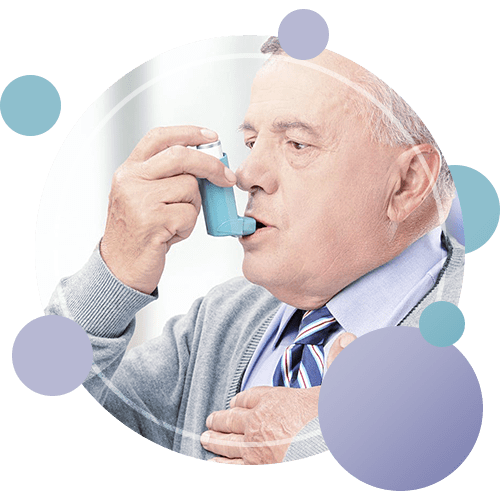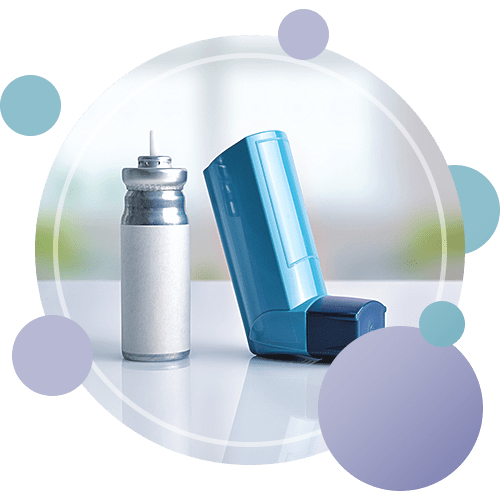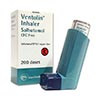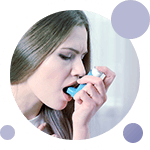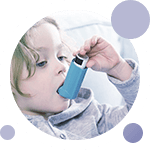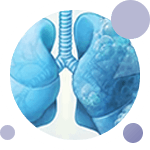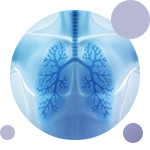Ventolin: A Breath of Life
Ventolin, whose base compound is Albuterol, is one of the most widely used medicines in the world. It is quite common for a person close to us to use inhalation device, especially if they are asthmatic. Surely it is Ventolin, an important treatment in asthma and other obstructive pathologies.
Albuterol was born from a clear need: bronchial spasms. For a long time, patients had severe difficulty breathing, but suddenly. These clinical pictures, in asthmatics, are known as "asthma crisis" and can lead to death. It is necessary to emphasize that it is not only asthmatics who suffer from it.
Therefore, it was decided to create a drug that would be able to suppress acute bronchospasms, to increase the diameter of the bronchi, so that the patient could breathe better during the crisis. Let us remember that these events happen spontaneously, in normally unforeseen situations, so it was necessary to have a "rescue" drug.
This is where ventolin, or albuterol, comes in, specifically designed to increase the survival of patients and save them during those sudden episodes of dyspnea. Without a doubt, it is necessary for the control of chronic pulmonary pathologies, preventing the patient from decomposing.
With the advance of technology, the way in which these medicines were used was gradually modified. In the beginning, the nebulizations were with long tubes and big machines that only through the air directly to us, however, things have changed a lot in the last time.
Today we have small, specially adapted devices so that we can carry them in our pockets and use them whenever necessary. Without major limitations and with a high effectiveness.
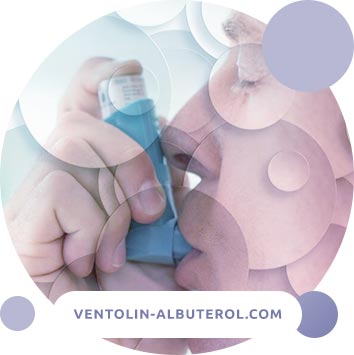
Let's talk a little about the generalities of this drug, but it also surrounds everything. We will not only limit ourselves to the characteristics of the compound itself, but also its mode of use and some important data that we need to know, especially if we are going to use it in the long term. What your doctor does not tell you, we will try to tell you.
The Science Behind: How It Works
Albuterol belongs to a large family called adrenergic agonists. These drugs can stimulate certain specific receptors to achieve a therapeutic effect. At effective doses, albuterol can stimulate the B2 adrenergic receptors found in bronchial smooth muscle, facilitating bronchodilation (increasing the diameter of the bronchi to increase the amount of air reaching the lungs) for a defined period.
It is important to point out that depending on the dose, the pharmacological effects are obtained, and this can affect the rest of the systems. For example, if albuterol is administered by inhalation (which is the most frequent), it will begin to take effect after 5 minutes, but a certain amount of the drug may reach other systems such as the cardiovascular system, causing tachycardia or other adverse effects.
In addition, it is also worth mentioning that between 10 and 20% of the dose is what reaches the lower part of the airways. The rest ends up in the oropharyngeal region, where it is later ingested and has no effect.
Similarly, this 10% is enough to exert its pharmacological effect. This is absorbed very well by the lungs where it will have its effect, although it is not metabolized. Later if it can reach the blood circulation and metabolize in the liver, although it will depend largely on the dose.
The important thing is to know that there is no risk with the part that is ingested, since it goes directly to the liver who metabolizes it and inactive to eliminate it through the kidneys. Albuterol, in general, is a safe drug that is used even in children.
Finally, this effect on the circulatory system has its explanation. Although the effect of ventolin is mainly in the lungs, let us remember that it is not the only system that possesses adrenergic beta receptors, the ones in charge of its main action. In fact, in the whole body we have receptors of this type, however, not everyone is affected by the action of this drug.
The main action is in the lungs when inhaled, so it will not remain in the blood for long. This limits the possible action that albuterol would have on other systems, such as the gastrointestinal or osteomuscular. As we mentioned, the truth is that Albuterol is a safe drug and that it can be used by almost anyone, although later we will detail the contraindications and all the specific data regarding the safety and use of this powerful agent.
Half-life: Why should it be Inhaled?
The half-life is the approximate time that a drug remains active in our body. In the case of albuterol, this period is approximately 6 hours, after this, there is no therapeutic effect of the drug.
Now, why inhale it? Simple: if our problem is pulmonary (the main use of Albuterol) it would be best to get directly to the site, and the only way to do so is to inhale it. If we had a skin problem, scrape or laceration, the best thing would always be to use something that has a direct effect, like some cream or some topical agent; the same thing happens with albuterol.
In addition, it is important to mention that it is considered a medicine "on demand", that is to say, when the patient believes that he needs it (because he goes into crisis or considers that he is running out of air) is that he will use it. If used continuously, as if it were any other drug, it could lead to secondary complications or a worsening of the disease.
In fact, it is possible that after continued use we may be left with a kind of "supersensitivity", where our body would go into much more frequent respiratory crises because it "got used" to the presence of albuterol in the airways. This is an important side effect that can be seen with the abuse of albuterol.
In addition, depending on the dose a patient needs to attenuate or eliminate respiratory distress, the physician may act. In other words, if he needs large quantities, the doctor will understand that the basic problem is serious and will certainly use second- or third-line drugs to strongly attack the respiratory problem.
Finally, inhaling albuterol (as opposed to using it intravenously) greatly limits possible side effects. As mentioned earlier, this drug can act on beta adrenergic receptors, which are found throughout our body. Therefore, if it was used intravenously, it is possible that - even though it had an effect - it also acted on the rest of the receptors, causing very annoying side effects.
Indications: Your Physician Decides
As we have mentioned throughout the article, the main use of albuterol has to do with lung pathologies. While there are countless possible situations where albuterol should be used, it should not always be applied. Here are some examples:
1) Acute Bronchospasm:
This is the typical example of asthma attacks, a lung disease that causes a decrease in the caliber of the bronchi, causing the airflow to be limited and therefore initiating a respiratory problem that can become very serious.
Still, it should be used as a "rescue" medication. In other words, let's remember that it is an acute event and that it probably won't reappear (depending on what the trigger is), so you only have to use one or two applications and wait for the event to stop. This is a fast-acting medication, so in a few minutes it should be resolved.
It is important to mention that not only in asthma you can appreciate these events, but there are also other diseases that cause acute bronchospasm, where Albuterol is also an option to highlight.
2) Allergy or Exercise
Exercise is a physiological state of stress where our body prepares to increase the amount of oxygen that enters our airways, that reaches the blood, etc. Therefore, it is necessary to close the bronchi a little to increase the pressure.
Therefore, people who have a baseline condition (such as asthma) need to use pre-exercise medications, such as albuterol, in order to withstand the full impact of this physical activity.
Second, people with specific allergies need rescue medications that they can use when they meet allergens. Albuterol is a good example of this type of medication, so it is normal for it to be considered an important option for patients to keep on hand.
It is necessary to clarify that this only happens in patients with allergic problems of pulmonary origin, given that it is here where the ventolin has its greatest action, but not only that, but other drugs of greater power are needed to treat important crises involving other systems. These drugs would include adrenaline and other powerful sympathomimetic drugs.
3) Chronic Therapy
Although we mentioned that albuterol should not be used as a continuous therapy, there are some cases where there is simply no other option. Let's remember that medicine always tries to cure the patient, but when it cannot, it leaves a type of treatment called "palliative", which only seeks to improve the condition of the person until the end of their days.
In the case of chronic therapy, it may require a large dose, or at least very frequent intervals. In this case, side effects do not matter much, since all that is sought is to improve the patient's condition by the end of his or her life. Doses of 200mcg may be used up to four times a day, instead of being used as a rescue medication.
In this case, it doesn't matter if you are a child or an adult, the dose would end up being the same. Depending on the condition of the lungs and the patient's underlying pathology, it may be used in conjunction with other medications dedicated to the same purpose: to improve the patient's quality of life.
Dosage of Ventolin
In the first instance it is necessary to emphasize that you should consult your doctor before using this medication, in fact, only the doctor can indicate it and explain under what circumstances you can use it. We remind you that our article is only descriptive and informative, so that you know what you are using, how and why.
Follow your doctor's instructions to the letter, doses will most likely vary depending on the patient or the pathology he or she has, as well as its severity. However, it will most likely follow an order like the following:
In adults, it is used to relieve acute attacks and can be used in doses of 100 to 200 micrograms. If you are a child under the age of 12, you will most often only use a 100-microgram application. However, as mentioned above, everything can vary depending on the type of activity and the pathology that the person is suffering.
In other special cases, such as when exercising, your doctor may tell you to use ventolin before you start, in order to condition your lungs for physical activity. In other words, before you begin to move, it is best to have your lungs dilated enough for air to flow properly through your airways.
As for the doses, they may be kept the same, even for continued use (in the few cases where it is needed). However, it is possible to use up to 800 mcg per day without being lethal. Even so, we remind you that you should only limit yourself to the doses that your doctor prescribes, remember that it is he who is considering the amount you need and the risks that are present, apart from the basic pathology.
How To Use
Remember that the frequent presentation of ventolin is an inhaler, therefore, the most important thing at the beginning is to remove the cap and shake the bottle a little, then press the inhaler and confirm that it is working properly. Ideally, the particles should be emitted with good power, so that it can perform the function properly.
Now, let's review step by step how inhalers should be used properly. Most patients use them in an inefficient way, so very little dose is what ends up reaching the base of our lungs (where we need it most).
- The protector that is covering the mouth adaptor must be removed. The important thing is that you do not apply too much force, but that you press the sides so that it comes out without much effort. Remember that all the parts of this inhaler are designed to work properly, so you should not need more effort.
- Properly check the interior of the inhaler to ensure the integrity of all parts beyond the mouthpiece, especially the area where the medication is supposed to be installed.
- Shake your inhaler well. Albuterol can be concentrated on the bottom of the bottle, so it is necessary to shake it to ensure that the concentration of the drug is appropriate when leaving. If you do not, the dose may be insufficient or too large, making it dangerous or useless.
- You should only use two fingers to properly take the inhaler, index finger and thumb. No more should be needed. Make sure your thumb lies below the mouthpiece and the other at the top.
- Exhale as much as you can without becoming uncomfortable, so that your lungs appear to be "out of air. Place the mouthpiece in your mouth but use your lips to apply pressure. Try not to let the teeth come into direct contact with the adapter.
- Now press the device and inhale deeply as soon as you press it. The idea is for you to take a deep, continuous breath so that the contents of the medication can reach the lungs more effectively and not get so lost in the gastrointestinal system.
- Hold your breath for as long as you can. Remove the inhaler and close your mouth while still holding your breath.
- If you must use more than one inhalation, we recommend that you hold the device upright before repeating step 3 through 7. In addition, it is important that you wait at least thirty seconds before reapplying the dose. Remember that there is a large part of the medication still floating in your mouth and looking to reach your lungs, so it is not appropriate to rush things, you will also be holding the air for a while, so you will want to breathe.
- Put the cap on your mouthpiece, do not leave it uncovered. Remember that anything could get in there and then travel quickly to your lungs when you use the inhaler again. If for some reason you feel that you are contaminated, use alcohol to properly clean the entire mouth area and the inside of it as well.
Cleaning Our Dispositive
Remember that this is a very delicate instrument that requires special care. It should be cleaned at least once a week. Remove the aluminum portion on the back of the inhaler and remove the adapter. Rinse everything without any special cleanser, just with warm water, that should be enough to be able to sweep away any saliva or other remnants.
Dry the entire case and its contents well, each of the parts that you washed with water. Remember that the aluminum bottle should not be submerged and that the focus of this cleaning are the plastic parts, not the bottle with the medicine. To finish simply tell me everything.
Contraindications and Precautions
The most important thing to know is that ventolin is a potent beta adrenergic, so any system that uses these receptors will also be affected. The one that should be highlighted with the greatest interest is the cardiovascular system, given that in a large majority of cases patients report that they feel palpitations or that their heart is "accelerated".
This is because in the heart muscle there are also beta-adrenergic receptors that increase the functions of the heart, such as contraction and rate of contraction. This side effect is limited and will progressively decrease as the concentration of the drug in the blood decreases.
On the other hand, you should be aware that as the base pathology worsens, the use of albuterol may become less and less effective, so you should consider using other rescue medications and start adding medications that can keep the base pathology under control.
If a dose that was previously effective is now ineffective, the most important thing is to consult your doctor as soon as possible. Some problem may exist both in the base pathology and in the way the drug is being applied, however, you cannot take any risks and it is best to assist again with your trusted doctor.
Some patients report that they feel cramping or that their muscles tire quickly. This is because beta-2 agonists (such as albuterol) can produce hypokalemia that can be quite severe. In fact, albuterol is also used as a medication to control potassium levels in those patients who have hyperkalemia.
Finally, we must beware of "paradoxical" bronchospasms. This is a rather rare side effect, but it can occur with the use of this drug. It is best to consult your doctor promptly if this happens, so that he or she is under control and then gives you another drug to treat your condition.
Albuterol is a widely used medicine, but it should always be indicated by a specialist. It cannot be used at its own discretion. Although it is a safe drug, it is likely that you do not need it except in specific cases, and it is your doctor who should tell you what those cases will be.
Undoubtedly, it is a medicine that came to revolutionize the history and control of serious respiratory diseases, especially those such as asthma that were a serious problem with acute crises.
Articles
Asthma: A Deadly Chronic Respiratory Disease
As we all know, asthma is an excessively common disease in our population, both adults and children. The central problem lies in the bronchi, part of our airways that are responsible for carrying air to our lungs, which are inflamed and begin to decrease in diameter, making it difficult for oxygen to pass through.
Various stimuli or allergens (substances capable of giving rise to an allergic reaction) are the main causes of this disorder, unlike chronic bronchitis, where it occurs permanently.

All of us can respond to an allergen. For example, if we spend all night sniffing paint, our airways will most likely become inflamed and we will have trouble breathing. However, people with asthma have an exacerbated and abnormal response to stimuli that normally do not affect them that way.
The most frequent symptoms are dyspnea, coughing, chest pain and a kind of wheezing. In fact, these symptoms become more evident when we go through an "asthmatic crisis," the climax of asthma that could lead to death if not properly treated.
Asthma in Numbers
As we mentioned from the beginning, this is one of the most frequent chronic diseases in the world, so it is not surprising that its prevalence is about 5% in the world's population. This means that at least 300 million people suffer from this disorder today.
These numbers are global, given that asthma in children is even more frequent, reaching figures of up to 10% worldwide. In fact, asthma is the cause of 250,000 deaths per year, especially in those regions where the control of this disease becomes more complicated, such as those with fewer resources.
The most important thing is that it is a pathology that represents a tremendous expense for the nation and for the people who are suffering from it. For example, just the complications (eventual crises that occur) could mean 300 to 1000 dollars a year. We're not even including the cost of maintenance medications or common consultations.
In addition, in adults it is usually associated with other pathologies such as sinusitis (inflammation of the sinuses, small pits that are in our skull around the nose), nasal polyps and the great association of the "atopic" patient, which we will explain later.
| Parameter | 100μg | ||||
| Ventolin MDI | Butalin MDI | P Value | |||
| Mean | ±SD | Mean | ±SD | ||
| Pulse rate/min | 83.7 | 8.6 | 85.6 | 8.2 | 0.45 |
| Diastolic Bp (mmHg) | 73.5 | 6.3 | 75.7 | 9.7 | 0.5 |
| Respiratory rate/min | 20.7 | 2.5 | 19.6 | 2.1 | 0.55 |
| ECG | Normal | Normal | – | ||
| Headache (%) | 0 | 2.3 | NS | ||
| Cough (%) | 1.1 | 1.1 | NS | ||
| Nausea (%) | – | – | – | ||
| Parameter | 200μg | ||||
| Ventolin MDI | Butalin MDI | P Value | |||
| Mean | ±SD | Mean | ±SD | ||
| Pulse rate/min | 86.5 | 7.5 | 84.8 | 6.2 | 0.24 |
| Diastolic Bp (mmHg) | 73.8 | 7.2 | 75.9 | 8.5 | 0.41 |
| Respiratory rate/min | 22.8 | 3.4 | 21.2 | 2.4 | 0.41 |
| ECG | Normal | Normal | – | ||
| Headache (%) | 2.3 | 3.4 | NS | ||
| Cough (%) | 0 | 0 | – | ||
| Nausea (%) | 0 | 2.3 | NS | ||
Causes of Asthma
This disease enters the great picture of "multifactorial" diseases and depends on the interaction between the genes (which is a predominant factor) and the environmental alterations surrounding the patient.
In the case of the hereditary relationship, there are several genes known as "susceptibility genes" that may be present in us and make us more likely to suffer from this disease. Most of these genes cause alterations in our immune system that facilitate the release of important factors and mediators in the allergic cascade.
Although there are many genes, we will only mention that in asthmatic patients are altered those that regulate the release of immunoglobulin E, interleukins, and even other factors that mediate the state of smooth muscle of the airways.
In terms of environmental factors, we have several important things to mention. The first is that there are several things that can predispose us or make us resistant to suffering from this disease, for example, exposure to allergens, diet and some factors related to childbirth.
Children who have never been exposed to normal environmental conditions, such as household allergens (mites, pets, etc.), have a higher risk of developing asthma either as children or as adults. Even diets that were poor in vitamins C and fatty acids had also been associated with this disorder, especially obese children.
Even when the mother is young (when procreating) or has problems with nutrition or the baby has some complications such as prematurity, the likelihood that the child will be born with this disorder increases exponentially.
However, the best and clearest evidence was the opposite relationship. That is, children and patients who were exposed early to all these allergens and who had healthy growth, even since they were in their mother's womb, were shown to have almost no chance of suffering from asthma or a similar chronic respiratory condition.
Types of Asthma
Classifications abound with this disease, so we are going to limit ourselves to explaining the most important and frequent within the broad world of medicine.
1. According to its Triggering Factor
She may be allergic, where the relationship to allergens is most important. The triggers in this sublevel would be pollen, plants, mites, pets, etc. Even so, they may differ a great deal from one person to another due to the various relationships mentioned above in the causes. Similarly, there is usually an important family history or the patient himself, who may have other types of allergies.
Seasonal allergies are related to the climate and the period of the year in which you are living. In this case, the patient worsens during the spring or late summer when the amount of pollen in the environment is much higher.
It may also be unrelated to allergic processes, but may be triggered by irritants. The preferred - or most frequent - are those full of toxins capable of directly injuring our mucosa and creating a disproportionate inflammatory reaction. Examples of irritants are smoke, deodorants, paint, perfumes, etc. The patient may even have a crisis due to rapid changes in the temperature of the climate or respiratory infections.
2. According to the Control
Not all patients are careful enough to maintain proper control of their disease. A large part of them are even unable to obtain their medications due to lack of economic capacity, which makes it difficult to control them.
We have the patients controlled, those who have no symptoms of any kind, even if they have the disease, but do not need rescue medication. It is difficult for this patient to fall into crisis or have flare-ups, so he has a good life expectancy.
On the other hand, we also have partially controlled patients, those who have symptoms two or more times a week and some or other unimportant nighttime symptoms. In these patients, they usually need to carry their rescue medication (to avoid crises) and usually have flare-ups.
Finally, uncontrolled patients are those who have frequent flare-ups, even once a week, which greatly decreases their life expectancy.
Of course, sometimes it is not just the economic aspect, but patients are not well treated by the specialists they have. Ideally, everyone should stay in the controlled asthma classification, and not end up with flare-ups that can lethally affect their lives.
Symptoms of Asthma
As we mentioned, there are some symptoms that may be key to determining whether a patient has this disease. However, let us remember that this is a disproportionate immune response that differs in all patients, so it is difficult for them to react in the same way or with a similar magnitude. Some of the most frequent are:
- Cough: without a doubt, this is the first one that appears, or at least catches people's attention. It is usually irritating and dry, which means it has little phlegm. What sometimes happens is that we expect an accumulation of saliva or wet secretions unrelated to what is in our lungs. It tends to increase at night and with any physical effort regardless of its magnitude.
- Dyspnea: Difficulty in breathing is the most important thing. Patients suffer from moments when they lose the ability to breathe normally. It usually appears after physical exertion, although some other activities (including eating chocolate) may trigger it.
- Wheezing: whistles in our lungs are incredibly frequent. The stethoscope is the tool par excellence to be able to listen properly to what is happening in our lungs. These are the product of the passage of air through the airways that have become very narrow, creating a turbid flow that manifests as a whistle.
- Chest tightness: It is also normal to feel pressure on the chest, especially when symptoms are worsening, or the patient is very complicated.
Diagnosis of Asthma
In most cases, diagnosis does not require many complementary tests since the fundamental expression of asthma is with seizures. However, a little more study may be needed. Still, the fundamental procedure for diagnosing asthma is as follows:
1. Medical History
Collecting data about what happened and how the disease is unfolding is crucial. In addition, it is necessary to collect information about your family and how this pathology has been presented in your family tree.
It is normal for it to start as a dry cough that usually appears at night with a breathing problem, or that you may have related it to exercise or physical activity. In addition, it is best to know if you have been exposed to any type of irritant in the past or to try to categorize at once the type of asthma you have.
2. Chest X-ray
The basic and fundamental examination for the analysis of respiratory pathologies is chest radiography. The most important thing with this examination is not to confirm that we have asthma, but to rule out other pathologies of the respiratory system that could also have similar symptoms. For example, it could be an infection that does not yet develop high fever, malformations, foreign bodies, etc.
Only in patients who have chronic asthma and who have spent years with the disease are those who may have some type of radiological alteration to guide the diagnosis. Even so, by that time the most frequent thing is that the diagnosis has already been made.
3. Spirometry
This is the gold standard for patients with lung problems. This is the only fundamental test for the diagnosis of asthma, including the severity of the picture. What is done is to evaluate our lung capacity through the exhalation of air through a tube connected to a machine specialized in this type of measurements.
The normal is that the test has values of 100%, so any slight alteration could be a clear confirmation that you have the disease. Even so, there are several parameters that are obtained through this study that can be evaluated and orientated towards the possible diagnosis.
Treatment of Asthma
Certainly, treating this disease can be a challenge in most patients. Non-drug measures, such as prolonged rest or the use of atypical medications that have unwanted side effects, are sometimes warranted.
1. Non-pharmacological Measures
The most important thing is to get away from everything that's wrong with us. For example, if after performing certain tests (such as the prick test), we discover that we are allergic to pollen, we should start taking specific measures. Some of them would be to avoid going out during the dry and sunny days, to use necessary coating like the anti-pollen filters, sunglasses, the windows up in the car, etc.
2. Pharmacological Treatment
A large amount of medication must be put together in every patient. They usually keep two different types of medications. First, the maintenance medication, which is the one that relieves symptoms normally. In the second instance, the rescue, which will serve for crises and exacerbations.
Anti-inflammatory drugs should be used, such as corticosteroids, which serve both inhaled (mild cases and maintenance) and intravenous (severe cases) to increase the diameter of the bronchi and allow more air to pass through. In addition, bronchodilators, immunotherapy, and even other specialized drugs are also indicated.
The ideal is for your specialist, the pulmonologist, to play with the combinations between all these medications in order to achieve the stability of the pathology. Of course, each one has its own indications and different contexts, but in most cases it is possible to achieve normality with them.
 DE
DE FR
FR IT
IT ES
ES